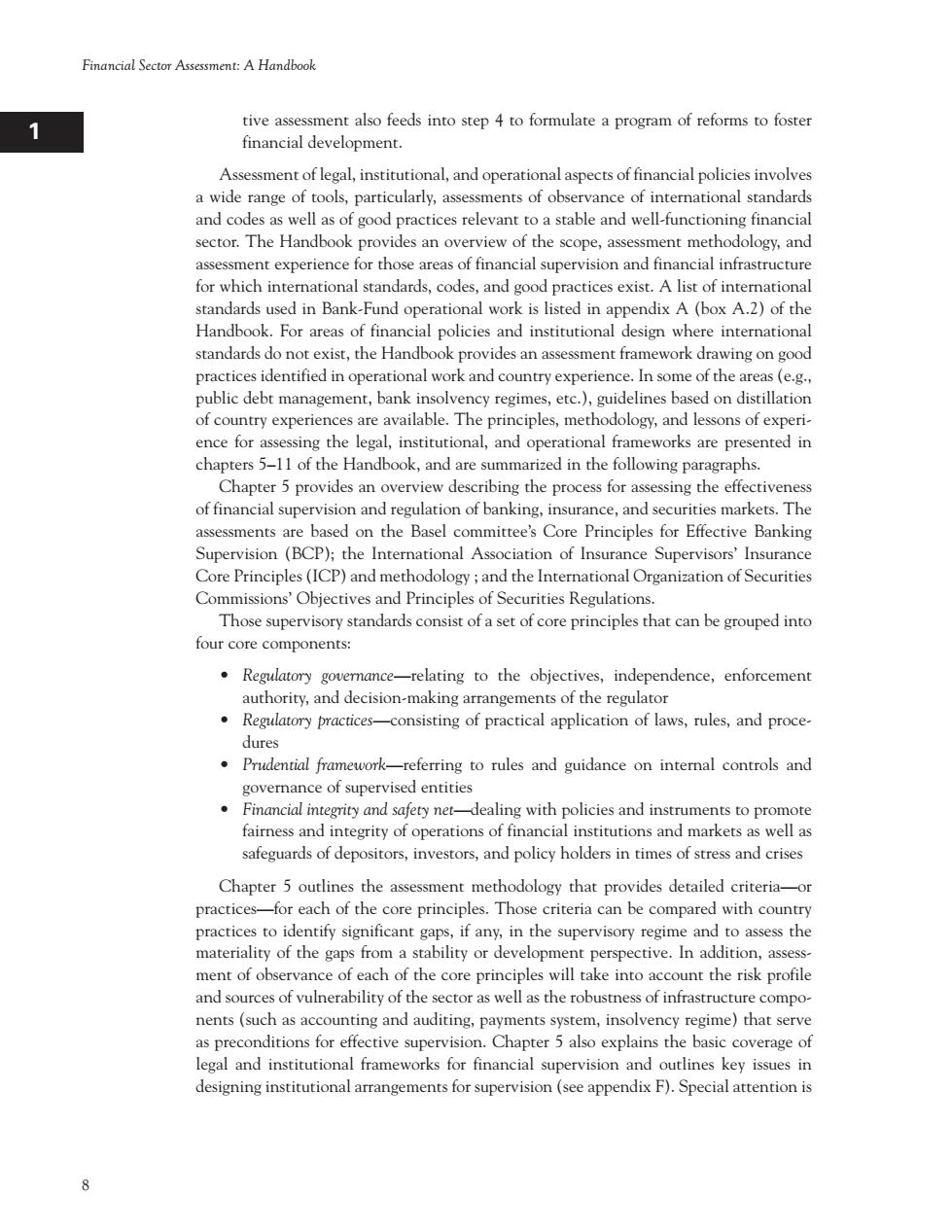正在加载图片...

Financial Sector Assessment:A Handbook tive ass ment also feeds into step 4 to formulate a program of reforms to foster financial development. Assessment of legal,institutional,and operational aspects of financial policies involves a wide range of tools,particularly,assessments of observance of international standards and codes as well as of good practices relevant to a stable and well-functioning financial sector.The Handbook provides an overview of the scope,assessment methodology,and sment expe ence for those a asofmanGilsgpeisonandfinancalinfnsmcure for which intematio ndards,code senBank-Fund (bxA.)of the Handbook.For areas of financial policies and institutional design where international standards do not exist,the Handbook provides an assessment framework drawing on good practices identified in operational work and country experience.In some of the areas(e.g., public debt management,bank insolvency regimes,etc.),guidelines based on distillation of country experic ace for ht The pnciples mth ofepen the legal,institutional, nd c rational frar works are e pr in chapters5-11 of the Handbo re summarized in the following p Chapter 5 provides an overview desc ibing the process for assessing the e ctivene of financial supervision and regulation of banking,insurance,and securities markets.The assessments are based on the Basel committee's Core Principles for Effective Banking Supervision (BCP);the International Association of Insurance Supervisors'Insurance Core principles (cP)and methodology and the International Organization of Securities missions'Objectives s and Princ ciples of securities regulation Those supervisory standards consist ofaset of core principles that cn be grouped int four core components: .Regulatory goverance-relating to the objectives,independence,enforcement authority,and decision-making arrangements of the regulator .Regulatory practices-consisting of practical application of laws,rules,and proce- dures Prudential framework-referring to rules and guidance on internal controls and rvised entit dealing with policies and instrumen s to prom fairness and tegrity of operations of financia 1 arkets as well a safeguards of depositors,investors,and policy holders in times of stress and crises Chapter 5 outlines the assessment methodology that provides detailed criteria-or practices-for each of the core principles.Those criteria can be compared with country practices to identify significant gaps,if any,in the supervisory regime and to assess the materiality of the g gaps from a stability or development perspective.In addition,assess. ment of obsery of each of the core principles will take into account the risk profile ctor as well sthe robust s of infr ents (payments system,in astr as preconditions for effective supervision.Chapter 5 also explains the basic coverage of legal and institutional frameworks for financial supervision and outlines key issues in designing institutional arrangements for supervision(see appendix F).Special attention is8 Financial Sector Assessment: A Handbook 1 I H G F E D C B A 12 11 10 9 8 7 6 5 4 3 2 tive assessment also feeds into step 4 to formulate a program of reforms to foster financial development. Assessment of legal, institutional, and operational aspects of financial policies involves a wide range of tools, particularly, assessments of observance of international standards and codes as well as of good practices relevant to a stable and well-functioning financial sector. The Handbook provides an overview of the scope, assessment methodology, and assessment experience for those areas of financial supervision and financial infrastructure for which international standards, codes, and good practices exist. A list of international standards used in Bank-Fund operational work is listed in appendix A (box A.2) of the Handbook. For areas of financial policies and institutional design where international standards do not exist, the Handbook provides an assessment framework drawing on good practices identified in operational work and country experience. In some of the areas (e.g., public debt management, bank insolvency regimes, etc.), guidelines based on distillation of country experiences are available. The principles, methodology, and lessons of experience for assessing the legal, institutional, and operational frameworks are presented in chapters 5–11 of the Handbook, and are summarized in the following paragraphs. Chapter 5 provides an overview describing the process for assessing the effectiveness of financial supervision and regulation of banking, insurance, and securities markets. The assessments are based on the Basel committee’s Core Principles for Effective Banking Supervision (BCP); the International Association of Insurance Supervisors’ Insurance Core Principles (ICP) and methodology ; and the International Organization of Securities Commissions’ Objectives and Principles of Securities Regulations. Those supervisory standards consist of a set of core principles that can be grouped into four core components: • Regulatory governance—relating to the objectives, independence, enforcement authority, and decision-making arrangements of the regulator • Regulatory practices—consisting of practical application of laws, rules, and procedures • Prudential framework—referring to rules and guidance on internal controls and governance of supervised entities • Financial integrity and safety net—dealing with policies and instruments to promote fairness and integrity of operations of financial institutions and markets as well as safeguards of depositors, investors, and policy holders in times of stress and crises Chapter 5 outlines the assessment methodology that provides detailed criteria—or practices—for each of the core principles. Those criteria can be compared with country practices to identify significant gaps, if any, in the supervisory regime and to assess the materiality of the gaps from a stability or development perspective. In addition, assessment of observance of each of the core principles will take into account the risk profile and sources of vulnerability of the sector as well as the robustness of infrastructure components (such as accounting and auditing, payments system, insolvency regime) that serve as preconditions for effective supervision. Chapter 5 also explains the basic coverage of legal and institutional frameworks for financial supervision and outlines key issues in designing institutional arrangements for supervision (see appendix F). Special attention is